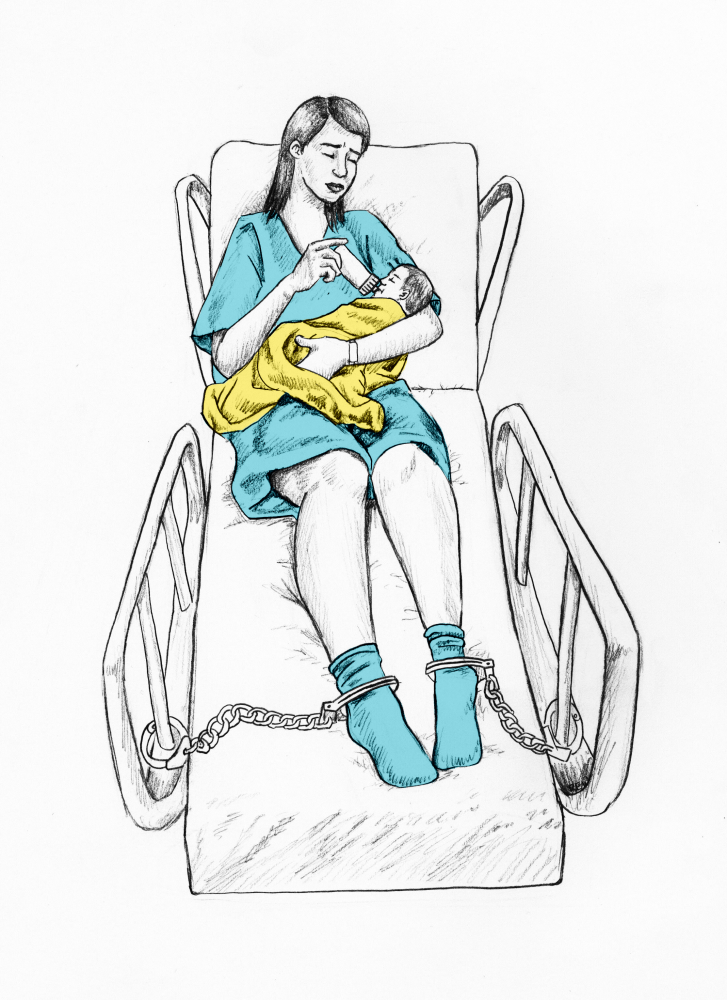Birth Behind Bars: Shackling Women During Labor
January 25, 2017
Shawanna Nelson, a prisoner at a correctional facility in Newport, Arkansas, had been in labor for more than 12 hours when she arrived at a local hospital in 2003.
Nelson shuffled in when she reached the delivery room with shackled legs. A guard chained her legs and hips to the bed while she gave birth. It was only after a doctor ordered her release during delivery that the guard removed the shackles. As soon as she had her baby, they shackled her again.
“She was outraged that she or anyone else would be subjected to such an experience,” said Amy Fettig, deputy director of the National Prison Project at the American Civil Liberties Union (ACLU).
Nelson is one of the estimated thousands who have given birth behind bars. The practice of shackling prisoners having babies has drawn increased scrutiny over the past decade of prompted legislators to pass bills to stop it. Still, prisoner rights activists say many states aren’t following their laws.
There are now more than 200,000 women admitted to U.S. prisons or jails each year. About 4 percent are pregnant at the time of admission, according to the ACLU. There is no official data on how many women give birth behind bars, but Fettig estimated that the numbers are in the thousands.
Eighteen states have laws that regulate and/or prohibit shackling pregnant women, 24 states have laws which regulate and/or prohibit shackling pregnant women in the correctional facility, and eight have no laws, according to the International Human Rights Clinic. When Nelson gave birth in 2003, only three states –– California, Illinois and Vermont –– had anti-shackling laws.
Nelson filed a federal civil rights lawsuit in 2004 against the Arkansas Department of Corrections. She lost: the court found that she could not prove the Correctional Medical Services policy of shackling was unconstitutional.
However, her case gained the attention of the ACLU. They helped her petition the circuit court to hear her case. She won in 2009, and the court found that shackling her while pregnant violated her Eighth Amendment rights: to be “free from cruel or unusual punishment.”
“That really raised the profile of the issue to be aware that this was a routine practice not just in Arkansas, but around the country,” Fettig said. “It made a huge difference. Activists around the country have risen to the challenge to pass laws that regulate the issue and prohibit the use of shackling on pregnant women.”
The Federal Bureau of Prisons and the American Correctional Association have created policies to restrict the use of restraints on pregnant inmates. The American Medical Association and the American Congress of Obstetricians and Gynecologists (ACOG) have also spoken out against the practice.
“We know that shackling pregnant women at any point is medically unsafe,” said Dr. Carolyn Sufrin, the ACOG representative to the National Commission on Correctional Health Care. “Labor is painful, so sometimes in response to pain, they need to be able to move their bodies around and shackles could interfere with that. It’s also a very degrading, demoralizing process and dehumanizing experience.”
Prison and jail policy was created with men in mind: male inmates have always been shackled when going to the hospital to ensure they are not safety threats. As a result, pregnant women are shackled in childbirth, Sufrin said.
“Our system assumes that pregnant women should be treated like all prisoners, and so pregnant women are treated as an afterthought,” Sufrin said. “You have to tell people that pregnant women are not threats [and] that it is dangerous to apply restraints.”
Like 63 percent of women in jail, Nelson was there for a non-violent offence.
Despite Nelson’s win in Arkansas, the state still has yet to pass an anti-shackling law. However, many states justify restraints because unrestrained pregnant women could be potential threats to the public’s safety and themselves, Fettig said.
“Though these are pregnant women, they are still convicted felons and sometimes violent in nature,” Dina Tyler, a spokeswoman for the Arkansas Department of Corrections, told the New York Times in 2006. “There have been instances when we’ve had a female inmate try to hurt hospital staff during delivery.” AWOL reached out to Tyler and the Arkansas Department of Corrections for comment, but they did not respond.
States also shackle women because they worry these women could run away. However, there have been no cases of pregnant women escaping because they were not restrained, according to the ACLU.
“Women in labor are going through often a very painful process and the chances that the woman is going to be a threat or run away is really unlikely,” said Sufrin, who has delivered babies from shackled pregnant women.
Fettig said that shackling makes this painful process worse through all stages of pregnancy. Before childbirth, shackling a pregnant inmate on the legs, hands and around the belly can be extremely dangerous because it can increase their risk of falling and not being able to protect the fetus, according to the ACLU. Shackling also raises the risk of harm during labor and postpartum and can prevent the mother from holding her child, which is often taken from her one day after birth.
“During labor, when shackled to the bed, and having contractions, that just increases the pain and decreases the woman and doctor’s ability to alleviate that pain and engage in natural childbirth,” Fettig said. “Having a woman chained postpartum is very risky and dangerous because [she could] have a blood clot if she does not to get up and is shackled to the bed.”
Sufrin said that shackling could cause life-threatening complications when emergencies arise during labor and delivery. Sufrin’s colleague had to perform an emergency cesarean section because her baby’s heart rate was in distress, but the guard was out for lunch. The doctors had to wait thirty minutes for the guard to unlock the inmate’s shackles and perform the C-section. The child barely survived. A delay of five minutes in an emergency like this could cause brain damage to the baby, according to the ACLU.
“There are risks of unpredictable pregnancies that can happen: bleeding, preterm labor, things happen without much notice sometimes,” Sufrin said. “And as a health care provider we need to take care of the patient, not negotiating with the guard to removing their restraints. That can be the difference between life or death.”
The Federal Bureau of Prisons said that even in severe cases, when delivering a baby or in postpartum recovery, restraints should never be used during labor and should be minimally restrictive.
Still, many states with anti-shackling laws do provide exceptions in extreme cases: when an inmate presents a threat to either herself or others or when there is an immediate risk of escape.
“With anything, you always have extreme circumstances, but that should never have to do with the health of the baby and the women,” Sufrin said. “All of those cases should be documented by the facilities so they can be under review.”
Many states do not implement the laws and continue to illegally shackle women because of a lack of oversight, Fettig said. A report conducted in May 2016 by the Prison Birth Project and Prisoners’ Legal Services of Massachusetts found that Massachusetts prisons and jails violated their anti-shackling law by continuing to handcuff women during labor and shackle their ankles and waist postpartum.
Reports showed that California, Texas and New York also did not initially change their policies after the anti-shackling laws were passed. Since the reports, California and New York have passed new laws and stopped shackling pregnant inmates, Fettig said.
“When the public isn’t routinely looking at what’s happening in prisons and jails, they can easily ignore state laws and not implement them unless they have accountability like mandatory reporting to the state legislature,” Fettig said. “So that has been shackling 2.0 because states have to go back and pass better laws or do reports and expose the facts that these laws haven’t been implemented.”
The ACOG recommends mandatory reporting every time a woman is shackled throughout her pregnancy, and recommends training for correctional officers to ensure that states are implementing the laws.
Women are the fastest growing population in jails and prisons, increasing 153 percent between 1990 and 2009, according to ACOG. The number of women giving birth in prison also increases every year. With this increasing population, cases like Nelson’s help bring this issue to the forefront of correctional reforms.
Fettig said that they are slowly seeing inmates get the community standard of care they deserve.
“The more states that pass laws, the more we can go to the courts and can say this is cruel and unusual punishment,” Fettig said. “These women should be provided the same care and dignity given to any woman in this nation giving birth. A child should not be born to a woman in chains in this country.”




